Grant Dixon An Interview with an Editor
In my 4 years plus in publishing first as a journalist, then an editor of community newspapers and finally, for years, editor then partner director of NZ Fishing News Fishing Media, I have conducted hundreds, if not thousands, of interviews. Finally, the time has come to write my own story who better to conduct the interview than me, with incumbent editor Nick ones helping to formulate the questions...
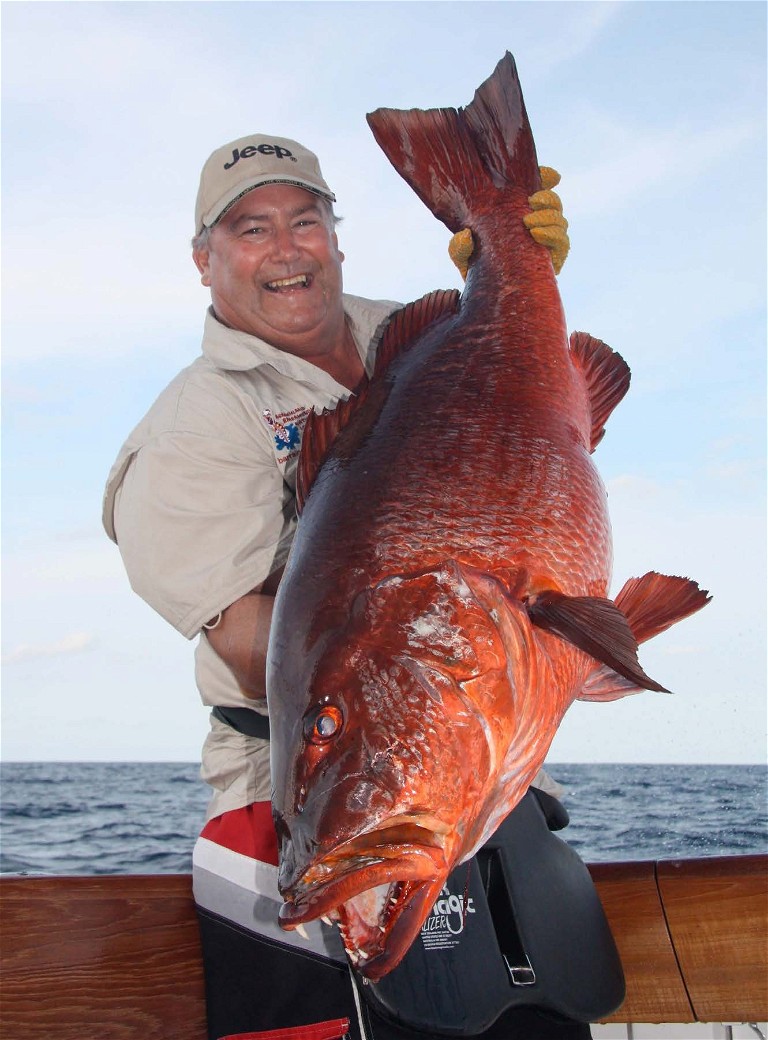
Grant’s role with the magazine has seen him explore some amazing destinations and species – in this case cubera snapper in Mexico.
Where did you grow up and how did you get into fishing?
Like many Kiwis, the fishing/hunting/outdoors/sports bug was passed on by my family – both sets of grandparents and Mum and Dad, Margaret and Ian.
The Dixon family had a bach at Kawhia, an hour’s windy drive ‘over the hill’ from our home in Te Awamutu. My first fishing trips were in the family’s Augustin 16ft cabin cruiser Jan Shiree when I was six weeks old. Apparently, I had a short attention span (nothing changes!) and spent most of that time on the water asleep in a bassinet up in the cabin.
It was on the waters of that west coast harbour that I learned the basics of fishing and boating. To keep me amused as a toddler, Dad would catch a small kahawai which he tethered on a length of handline and I would ‘play’ this fish for hours while Mum and Dad got on with the more serious stuff of providing for the family. There was quite a network of friends who had holiday homes there and together we netted and speared flounder, gathered shellfish, targeted a range of species, and generally enjoyed free-range freedoms many modern ‘helicopter’ parents wouldn’t dare allow their children today. We would have breakfast, head off on some adventure together, and not return until hunger pangs called us home for dinner.
My grandfather had established a great relationship with local Māori, and it was not uncommon for us to drop off sharks and stingrays at the marae where they would be dried on outdoor racks for future consumption.
While the bach was ultimately sold, the fishing seeds had been sown and the west coast today is still a special place for me. As our boats got bigger and more reliable, trips over the Kawhia bar featured regularly on our fishing agenda. It was where I snagged my first 10lb crayfish, caught my biggest ever snapper (28lb on a longline – I know, it doesn’t count!), and skippered my first gamefish – a 30kg yellowfin tuna caught by good friend and longtime fishing and shooting buddy Paul Davies. I also gained an appreciation for the respect you need to give bar crossings!
Mum and Dad later owned a 19ft Pelin cabin boat, Optimist, which was set up for overnighting. Mum was very much a fair-weather sailor, so they spent a great deal of time trolling for trout in Lake Taupo’s western bays.
One weekend brother Greg and I were away on the boat when we met up with a bunch of Hawkes Bay ‘fathers and sons’ who made twice-yearly sojourns for special weekends in May and October. We were given honorary HB status and joined their group for a number of years.
Another good friend, Mike Germann, and his dad, Owen, introduced me to trout fishing on the Waikato River lakes – Arapuni mainly – and later, once we had driving licences and cars, I spent a great deal of time fishing those waters, especially spin fishing the dam and tributaries at Waipapa with Mike, Paul and another friend, Gary Redgate. We caught some great fish, a number of which were on our own home-tied rabbit fly variations.
In our senior college years we would go fishing before school and were often late for class. One of the head teachers, Paul Hobbs, caught us sneaking into class and told me in no uncertain terms, “You will not make a career out of fishing,” and that I needed to get my act together scholastically. I never really did master the latter, but managed to ace the fishing thing! I caught up with Mr Hobbs a good few years later and reminded him of his forecast and the outcome – that I was editing a fishing magazine. He saw the humour in it.
What profession would you have pursued if you weren’t with the Fishing News?
Straight out of secondary school, I went to Hamilton Teachers College. The lecturers had the same issues with me that Mr Hobbs had – I was spending more time fishing, shooting, diving and playing sport (I was reasonably handy when it came to golf and tennis) than I was attending lectures.
I did manage to graduate and spent a year teaching at Te Awamutu Intermediate, then two years at Taupo Intermediate. I tended to be in my classroom very early in the morning, but would race the kids out the gate in the afternoon with a dusk fishing excursion in mind!
I was offered a job as a reporter by John Warburton, another hunting/fishing buddy, whose family owned the Te Awamutu Courier. We agreed on a threemonth trial – several decades before that became part of employment law – after which I signed on permanently. Because we had to often work weekends covering community events, once the paper was on the press on a Thursday midday, we would often head over to Kawhia for an afternoon fish and dive. I recall many Friday mornings when I struggled to type as my fingertips were cut up from wrestling with big west coast spiny reds – it was almost a badge of honour! During the gamebird season we would often spend our lunchtime flushing mallards out of the willows on a close-by farm that had once been owned by my grandparents. Can’t do that in Auckland!

1) Snapper covers sell magazines. Grant with Volume 1 (November 1978) and then a later magazine (December 2016), both featuring NZ’s favourite fish.

2) A bigeye tuna (133kg) nailed a skip bait at the Three Kings when fishing on 24kg tackle on board Arenui, skippered by Geoff Lamond.
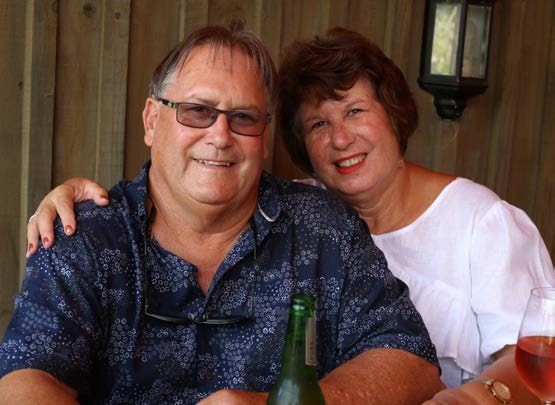
3) Grant wishes to thank Faith, he couldn’t have done it without you.
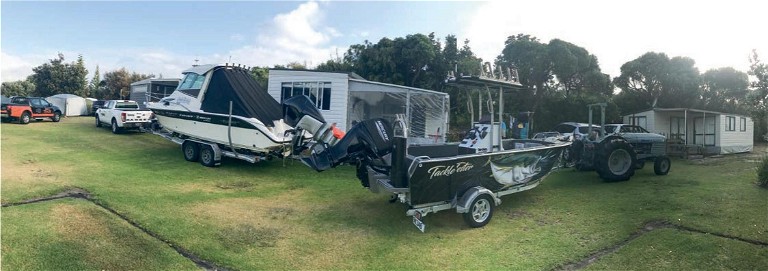
4) For over 20 years the family enjoyed an annual site at Camp Waipu Cove, spending over 100 nights there some years.
I was quickly taught two key things on the job, which led to my appointment as editor. Firstly, deadlines wait for no man and there was no place in a newspaper office for a clock watcher; secondly, it taught me journalistic integrity. That person you had written about lived in the same small rural town as you, and you would likely bump into them in the street, the golf club or the pub, so you had better have treated them fairly in your articles/editorial.
I was the court reporter for most of those 10 years at the Te Awamutu Courier and ’everybody’ who appeared in the District Court got their name in the paper, regardless of how minor or serious the charge was.
My own grandmother was involved in a minor traffic accident and was charged with a careless driving offence. I represented her in court and handed up all the usual platitudes that I had heard the defence counsels offer in the past – how hard could it be? Nana pleaded guilty and I dared to suggest to ‘Hanging Judge’ Michael Green that the offending was at the minor end of the scale. His honour saw it differently and Nana was fined $30 and $15 court costs.
At lunchtime the lawyers, judges and court staff would all sit around the table and chat. Judge Green, with the hint of a grin, suggested I stick to journalism and leave law to the professionals! Another career option down the gurgler!
At one stage when the Aussiebased Fairfax media company purchased the Independent Newspapers Limited’s NZ interests a few years after I had been made editor, I was offered the chance to join then NZ Fishing News Manager and good friend Mark Airey, and his wife Jude, in setting up Spot X Publications. We only had a short time to make a decision and as Faith and I were risk-averse, chose not to run with it. Mark and Judi went alone in the venture, producing a range of the popular Spot X books on where to fish, boat, hunt, guide, golf, camp and the like. I was signed on to the magazine as a lifer!
What are your favourite fishing destinations?
I get asked this quite a lot and my stock reply is, “Wherever I am fishing at the time.”
I have been very fortunate to fish extensively throughout the globe and New Zealand. My family has had a long association with Bream Bay. We had a permanent site at Camp Waipu Cove for several decades until the Department of Conservation (make that Confiscation) decided annual site holders were no longer welcome. The silver lining to that call was Faith and I purchased a home in Mangawhai with our retirement in mind, and it has worked out that way.
Bream Bay with the Hen and Chicks and Mokohinau Islands within reach is my favourite playground with lots to offer divers and anglers. Offshore, the Ranfurly Banks and the Three Kings both have special places in my memory banks.
On the world stage, the Pacific Islands are relatively inexpensive to fish – Samoa, Vanuatu, Niue, the Cooks, and Tonga have all had a part to play in my angling education. Further afield, Guatemala’s sailfish and Mexico’s yellowfin tuna have produced special moments, as has most recently Canada where we targeted salmon, halibut and sturgeon at various locations. Good friends Tony Orton and Bea Bagnall, who until recently operated Offshore Adventures, have been a big influence when it came to the introduction of new and exciting foreign destinations.
I was lucky enough to spend nine days with Tony and Bea in Mexico where I fished on board the 82ft Viking Norby as the sole angler. Apart from some great fishing, especially catching yellowfin on topwater and jig gear, it was the experience of a lifetime seeing how the other half lived!
What is your most memorable capture?
Few people forget their first billfish. Mine came in Samoa when fishing with Peter Meredith and the late Max Rassmussen who operated a charter business, Samoa Marine. Sam Mossman and I were over there for ‘work’ and out on the water Sam gave me the first strike which I converted with a mahimahi. Soon after a blue marlin came into the spread. Sam gave it up for me and my first billfish was duly landed, a blue of 150kg or thereabouts. I thanked Sam for his generosity to which he dryly replied, “I might have thought twice about it had I realised how big it was.” Thanks mate!
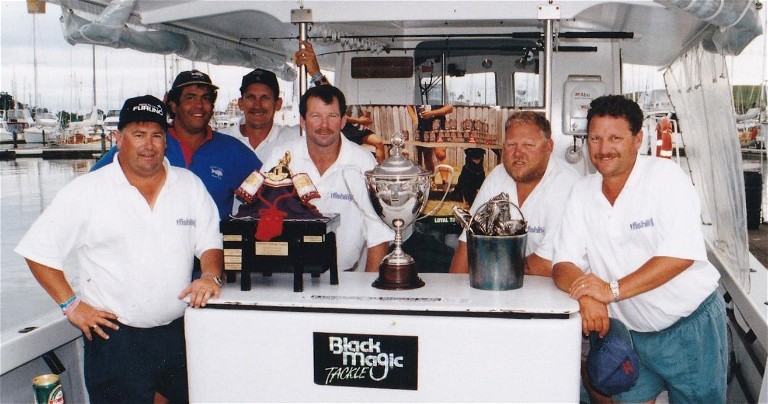
5) For many years Grant and the Fishing News team chased the tournaments. The crew aboard the Rex Smith skippered Kiwi Angler with the spoils of victory from a Furuno tournament.
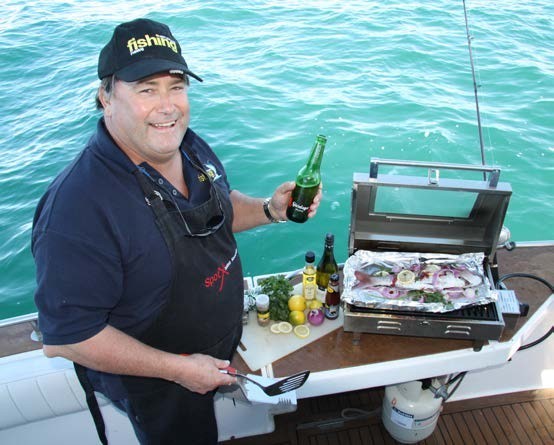
6) If you think you have seen this image before, you are not mistaken. It was on the cover of a Spot X cookbook compiled by Mark Airey and Grant.

7) Overseas travel has been a highlight of Grant’s career. A couple of nice Costa Rica mahimahi caught on a Tony Orton/Bea Bagnall-led trip.
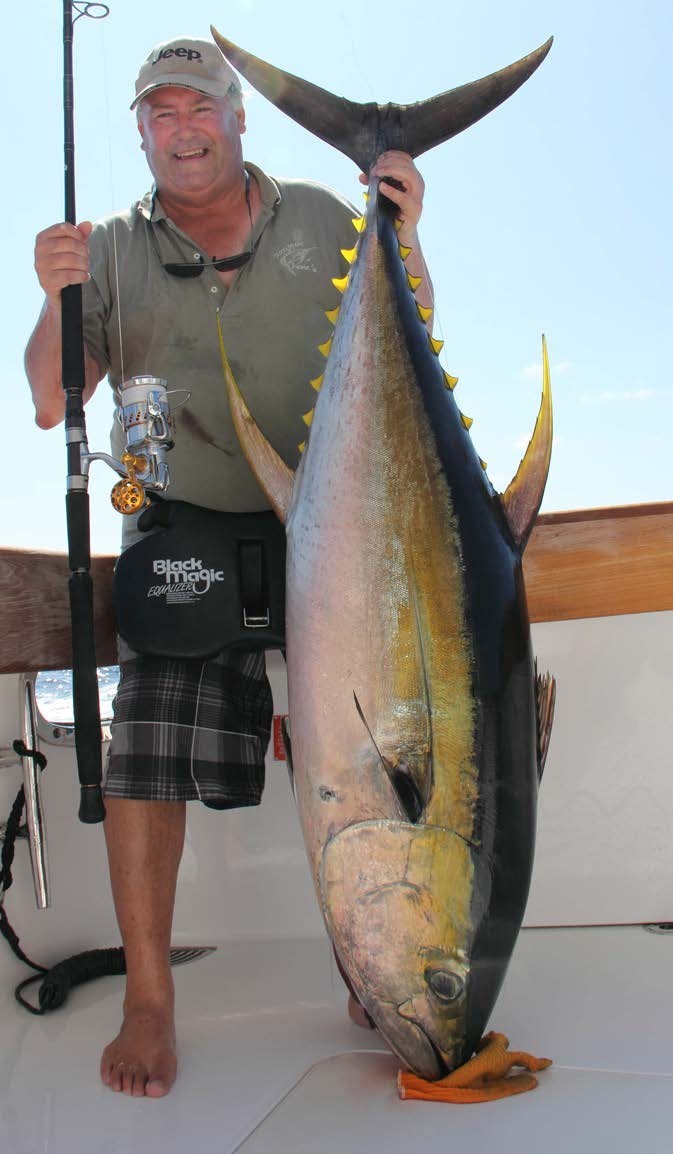
Some of Grant’s most memorable captures have involved yellowfin tuna. This 50kg plus specimen was taken on topwater gear.
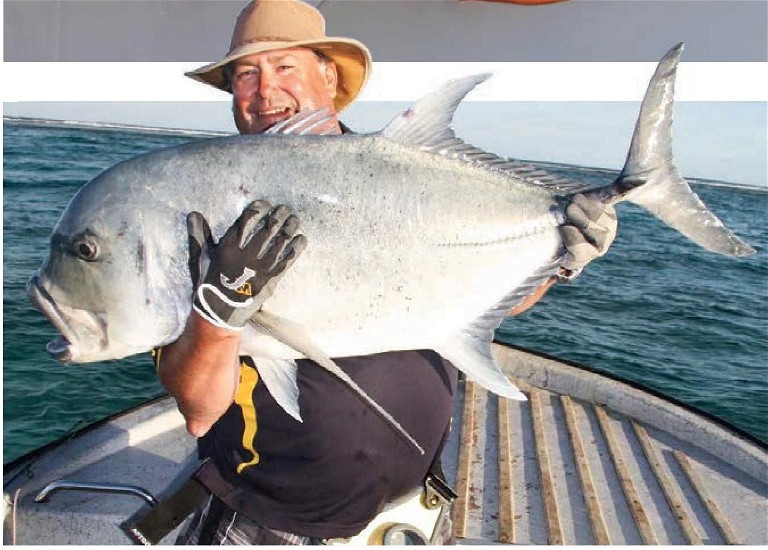
Since then there have been many special captures – cubera snapper, roosterfish and yellowfin tuna in Mexico, sailfish in Guatemala, blue marlin in Costa Rica, GTs, wahoo and dogtooth tuna throughout the Pacific… the list goes on. In NZ, fishing off the rocks with Pete Lamb and Bruce Basher in Henderson Bay, Houhora, and catching a 40kg kingfish was another special moment.
While filming an episode with Matt Watson for The ITM Fishing Show out of Whangaroa, I landed my official PB snapper of 11.9kgs (26.53lb). The episode was called How to Win a Fishing Tournament and we did! Another special moment.
Would you like to mention any mentors/ people who have influenced your fishing?
Everyone you fish with has something to add to your angling education, even if it is not how to do it!
When I was offered the NZ Fishing News editorship I was an occasional reader of the magazine with two names in particular – Sam Mossman and Mark Kitteridge – standing out. On the freshwater scene, the late Keith Draper was another font of knowledge, especially when it came to Lake Taupo and its tributaries. He introduced us to Waitahanui Cocktails – a delightful blend of dark rum and Stones green ginger wine!
When I started in October 1993, both Sam and Mark, who had forgotten more about fishing than I knew, were welcoming colleagues and I owe them a huge debt for their patience as I picked up the reins. They have both over the years helped me see sense, modifying my more petulant From the Helm commentaries! Sam has an amazing memory for piscatorial facts and figures, so made a great resource as well as writer.
Every skipper I have fished with has contributed in some way to my knowledge base – John Gregory, Bruce Smith, John Batterton, Geoff Lamond, Jeff Strang, Rex Smith, Alan Stark, Bruce Martin, Tony Orton, Peter Phillipps (Vanuatu) and Dave Arrell, plus many more. In the early days on the job, I fished quite a bit with Dave and wife Sue, quite often as the deckie with a bunch of mates on board. It was a great learning curve as Dave allowed us to be hands-on. He was a bridge between old and new schools of thought when it came to gamefishing, as well as being a great source of knowledge as to the sport’s history.
What I love about the marine/recreational industry is the passion of the people involved. Many of our marinerelated businesses are driven by owner/operators who live for their fishing and boating. Hanging out professionally with so many like-minded people has been fulfilling career-wise.
Our partners in NZ Fishing Media – Grant and Marie Blair – have been a big part of the business. I am not great with numbers, but they are thank goodness. Cheers, guys. And a big shout out to the many great staff members I have worked with over the years.
Can you single out one innovation that really changed the landscape of fishing in NZ?
That’s easy – braid. This has been a game-changer for myself and thousands of anglers. With finer, stronger fishing line has come changes in techniques for everything from gamefishing through to deep dropping for the cellar dwellers, to lure fishing for both inshore and freshwater species, and topwater casting for kingfish and a range of the Pacific species for the travelling angler.
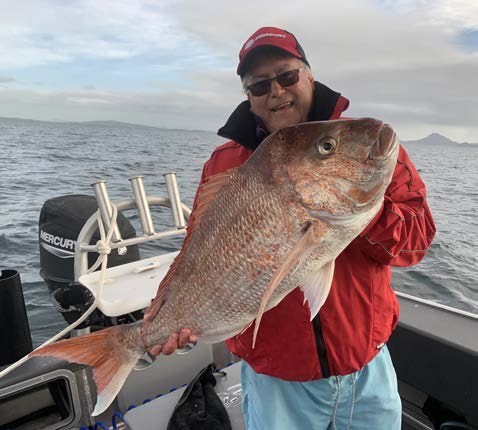
Bream Bay is one of Grant’s favourite haunts – for good reason.
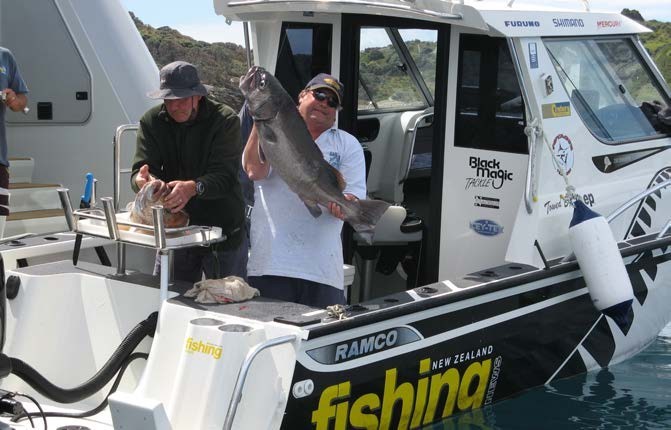
Hosting trips has been a fun part of the job. In this case, an adventure to Great Barrier aboard Island Passage.
We now use lighter gear for everything. Because of its low volume, braid can be used for gamefishing and top shot with various line class monofilament, while we have seen softbaiting and hard-bodied lures revolutionising snapper fishing. And with the line has come the rods and reels to fish it.
What’s your best piece of fishing advice?
Fish your feet first. This applies to all forms of fishing – be it for a snapper in Bream Bay or a marlin in the Far North.
How many times have you charged over the horizon, only to return to the ramp with a minimal catch to hear the crew next to you had ‘killed the pig’ just a few minutes from the launch point?
The above advice goes hand in hand with ‘do your homework’. As modern anglers, we have many sources of information, mostly online, as to what is happening in any given fishery. Talk to people at the local fishing club or tackle outlet, most are willing to point you in the right direction when exploring new territory.
How has recreational fishing changed over time?
When I first started fishing we did not have the benefit of the technology we enjoy today. I once heard it said that the average depthsounder/ charterplotter has more computing power today than the technology used to put the first manned space flights together.
Technology has put a huge amount of pressure on our fishery – marine electronics no longer just indicate the depth, they sort out the size of individual fish, the type of bottom – in 3D - and temperature breaks to name but a few. It can put you back to within a metre or so of your favourite/productive spot every time.
The biggest change has been in recreational fishers’ attitudes. Far more respect is given to the catch both in the way it is cared for (ikiied, iced, bled), taking a page from the fishing industry’s book. We now see greater utilisation of the catch, thanks to strong campaigns initiated by the NZ Sport Fishing Council’s public outreach arm LegaSea and its Kai Ika project, all well supported by the magazine.
People are more likely to limit their catch, just taking what they need rather than what they are allowed. Anglers have become more selective as to what they keep for the table, putting the bigger fish back.
Another important move is to measure rather than weight-based tournaments. NZ Fishing Media has flown this flag for many years, thanks to the initial efforts of Managing Director Grant Blair who has been the driving force behind the Export Fishing Contest, updates for which appear monthly in this magazine. Anglers have bought into this and you often hear them talking in centimetres when describing their catch rather than weight.
Interestingly, trout fishery managers were instrumental in having this species removed from the Export competition. I thought they would have been all over such a conservationorientated event.
Fishing is said to be one of the most dangerous sports – what have been your hairy moments?
Fire on board is one of a mariner’s worst nightmares. We were fishing the marlin highway in Vanuatu aboard Peter Phillipps’ 34ft Blackwatch on a lay day during an ITM-hosted client trip away. Skipper Matt Smith noticed smoke coming out of the starboard motor and on lifting the engine box found the area fully engaged. We pumped three or four extinguishers into the area to no avail. We were forced onto the bow to activate the life raft, jumping overboard and scrambling into it. Luckily the crewman had managed to get a mayday call out which was answered by a skipper back in port, who sounded the alarm.
In the meantime, Matt, the deckie, two other guests and myself were in the raft. Matt was going over the process and suggested the only thing he hadn’t done was send up a flare. I tactfully mentioned there was nothing we had at our disposal that was going to create as much smoke as the boat burning to the waterline behind us!
The main lesson to come out of the incident was lifejackets should be accessible in an emergency. The ones on board were up in the bow and we couldn’t get past the flames to grab them. The other was just how difficult it is to move forward a round raft with a single paddle!
You have never been afraid to speak your mind – do you have any comments regarding the politics of recreational fishing?
Unfortunately, politics invades all aspects of our daily lives and fishing is no exception.
Recreational fishers have always been the poor cousins in any negotiations with commercial and customary Māori interests coming first thanks to a flawed quota management system and a much manipulated and maligned Treaty of Waitangi. Anglers have enough to worry about in their daily lives without getting involved in the politics of their one outlet from the daily grind – their fishing. There are 600,000 of us, imagine what could be achieved if we all voted with a single voice. It is not going to happen, but the potential is there.
I make no secret of the fact I back LegaSea to the hilt. They have been the only truly lone voice in representing recreational fishers nationally over the last decade or so, especially since the demise of the NZ Recreational Fishing Council.
I have always tried to attack the principle, not the person (the exceptions are some ministers of the Crown). The fishing industry has sometimes come in for a spray, especially when the mighty dollar takes precedence over any stock or environmental concerns. What I have been mindful of within those industries and Government departments is that there are many people on the ground doing great work and I respect that – our fisheries compliance teams, DoC workers, and the crews working the decks of our commercial fishing fleet. It is the decisionmakers and shareholders I have issues with.
I’m sure the NZ Fishing News crew got into some debauchery back in the day – can you share a funny story?
There have been plenty, especially in the earlier days. One that sticks out in my mind involved a well-known personality (and practical joker) in the industry who worked for us. We had all been the butt of his jokes at some stage or another.
He was about to go on a trip to the islands representing the magazine, and over Friday drinks one of the staff asked if he was up to date with his inoculations, in the belief these would be necessary to ward off any tropical diseases. Playing along with this I ran off a couple of the more common ones – Hep C, beriberi, malaria, etc. – and suggested if he hadn’t had them, he should.
I contacted his wife to tell her what we had done and to get her to buy into the prank. She also mentioned our man had a morbid fear of needles. By chance the next week they were both going to their family doctor where the matter of jabs arose. It turned out he had fallen behind on the more common NZ issues such as tetanus and the Doc suggested Hepatitis C wouldn’t be a bad one to have either. Nailed him!
We have all seen the cartoons depicting a hapless angler hooking a gumboot. On a trip to Hawaii we were trolling lures along a current line and one of the rods went off. What had tripped the clip turned out to be a gumboot, a case of life reflecting art!
We have the Bent Propellor Trophy in the office, presented to the staff member for some boating/angling fail. I have been the recipient of the trophy on several occasions, the worst incident was hitting Mussel Rock at the entrance to the Whakatane rivermouth. And before you laugh, just remember there are two types of skippers in this world – those who have hit rocks, and those who are going to!
What will stepping away from the magazine look like for you?
Faith and I have travel plans, starting with a family trip to Niue later in the year. I have some other irons in the fire around fishing travel.
And on those five-knot variable forecasts I can sneak out for a fish when I feel like it, not when editorial commitments dictate. I love writing, be it personality pieces, boat reviews or tackle tests, so will be producing those for the magazine on an if- and when-needed basis.
Any last words?
It would be extremely remiss of me not to acknowledge my family. Faith brought up our two daughters, Natalia and Miah, almost singlehandedly in the early days of NZ Fishing News. I was away a lot, soaking up a new job, and she was left at home with a teenage daughter and a newborn, and there was not a lot of spare cash having just bought a house in Auckland.
I was so engrossed in what I was doing, Faith said the family played second fiddle to the magazine and she was right. It took me a little while to realise fully the situation. Today the tables have turned – Faith was a fishing widow then, today I am a golfing widower!
One of my proudest moments was when Miah joined us at NZ Fishing News, firstly as a deputy editor and then as editor. She has since moved on to bigger and brighter things in the IT world.
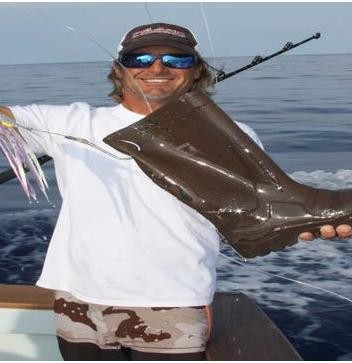
You have all seen the cartoon where the angler catches a gumboot – this is the reality version.
I am leaving the magazine in great hands editorially. Nick, with his broad skill set and fantastic work ethic and passion, has taught me that I can step back and, unlike Henny Penny, the sky will not fall on my head.
It was a bold move for the families when Grant and Marie Blair first discussed combining our resources to purchase the title from Fairfax. We had complementary skill sets – mine was creating content, while GB and Marie’s were crunching the numbers and the ideas. We have built a good team around us.
I have never seen myself as a great angler, but more a conduit to sharing the information of others who are. It has been a great ride.
I will sign off with a quote from Confucius that best sums up my time with the magazine:
“Find a job you love and you will never work a day in your life.”
He knew a thing or two that man!
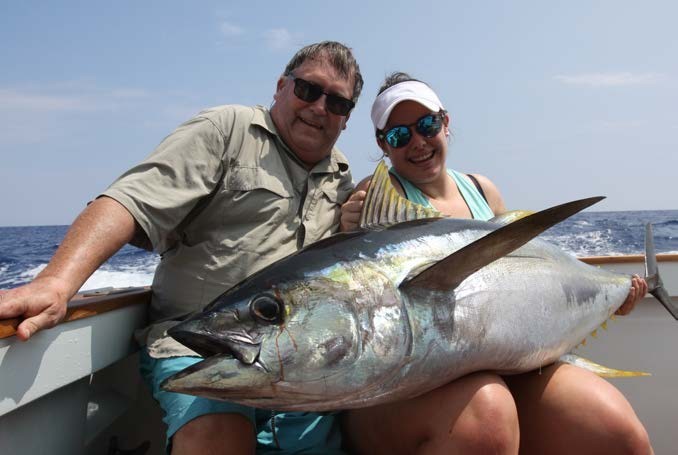
Father daughter bonding. Miah with a 78kg yellowfin caught in Hawaii on a family holiday.
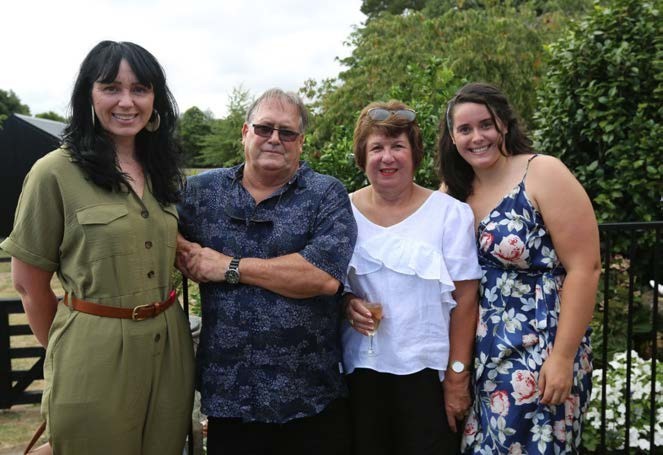
The Dixon clan have always been supportive of Grant’s work.